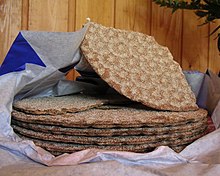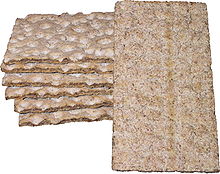crispbread
Knäckebrot ( loan word from the Swedish knäckebröd from knäcka , "crack") is a flat , dried bread , mostly made from whole grain cereals .
properties
As a rule, crispbread has a high fiber content. Typically, 100 grams of crispbread contains 15 to 18 grams of soluble and insoluble fiber.
Manufacturing
Crispbread is baked very briefly and very hot and then dried. After that, it contains almost no water (less than ten percent), which makes it crispy and has a very long shelf life if stored in a dry place. This was particularly important in earlier times, when the preservation of food was a major problem: crispbread has the advantage that it can be baked well in advance. It usually has a characteristic trough pattern and consists mainly of rye meal and finely ground flour made from rye and wheat .
species
According to the method of loosening the dough, there are two types of crispbread:
- Cold bread
- Loosening with cold air. The dough is cooled to almost zero degrees Celsius and loosened by blowing in the cold air (examples: milk and light rye crispbread).
- Warm bread
- Loosen up by adding baker's yeast . The subsequent two-hour fermentation in the warm (plus subsequent fermentation of around 45 minutes on the so-called fermentation streets ) doubles the volume of the bread (examples: sesame and dark wholemeal crispbread).
A waffle bread of a similar shape and consistency, but with different ingredients, is Filinchen .
history
Crispbread is originally from Sweden . Today it is mainly produced industrially. The first crispbread in Germany was made in 1927 by the First German Knäckebrotwerke Dr. Wilhelm Kraft in Berlin-Lichterfelde . The company was relocated to Burg near Magdeburg in 1931 and still exists today as Burger Knäcke GmbH. Barilla is the largest producer of crispbread in Germany, the bread is baked in Celle and sold under the name " Wasa ". The European market leader for organic crispbread is Dr. Klaus Karg KG.
Packing, handling
Sliced crispbread is typically offered in airtight packaging, often in shrink-wrapped paper with a plastic layer, often with a separate banderole with a print. Depending on the recipe and slice thickness, the net weight varies by around ± 15% with the same pack format. The stated package weight ranges from 190 to 275 g. The tight packaging protects against moisture and gradually against oxidation by oxygen and pests. Around 1970 Wasa offered two-part polystyrene boxes made of a beige tub (with 4 foot knobs and slightly raised grooves on the inside to prevent the hard disks from slipping) and a yellow-transparent lid with a folding fold, which exactly held the contents of a paper package and the bread Protect something against the ingress of moisture.
Crispbread is brittle, so it breaks quickly when bent. Crispbread is made with a low-salt content in order to draw in little water vapor from the air; however, depending on the relative humidity, it becomes significantly softer in a living environment within hours or days, which means that it loses its popular crispness.
Individual evidence
- ↑ BÄKO brands and service (ed.): Crunchy addition to the range of baked goods (= BÄKO magazine ). Chmielorz, September 2001, ISSN 0939-5571 , p. 51 ff . ( Online [accessed September 12, 2013]). Online ( Memento from March 5, 2014 in the Internet Archive )
- ↑ Schaaf Technologie GmbH: Videos of extruders in action , u. a. Crispbread (flatbread).
- ^ Uwe Ritzer : Baker with a doctorate. In: Süddeutsche Zeitung . June 2, 2006 ( PDF; 2.275 MB ).

